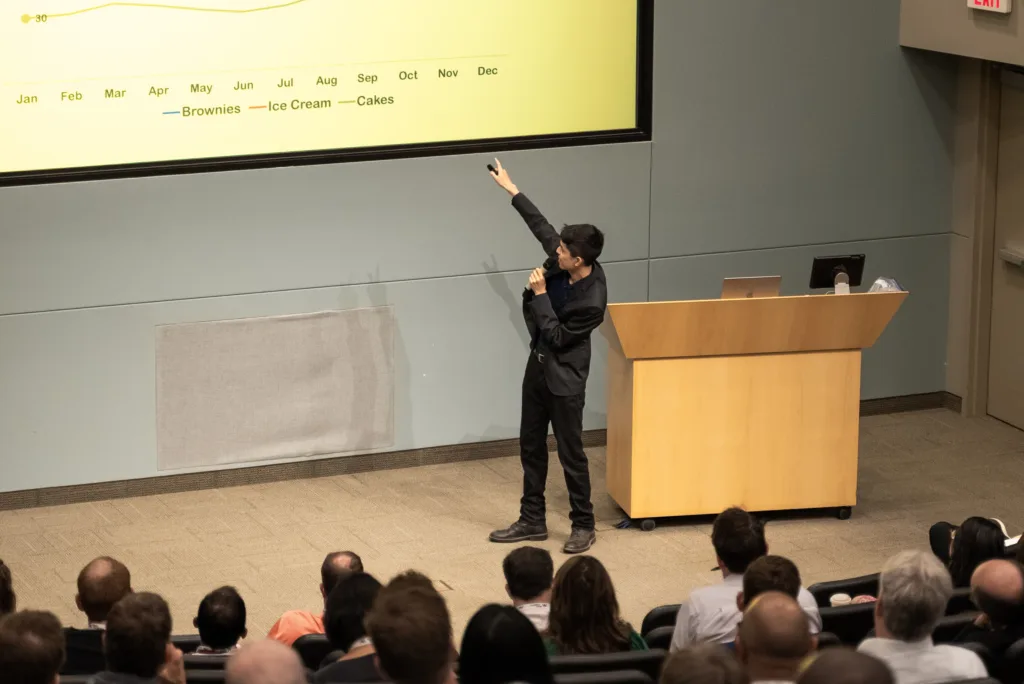One of my greatest frustrations as an introvert was how to add value to a conversation when I’m the quietest, softest, or least-fast-thinking voice in the room.
As an introvert, I also strongly dislike hogging the spotlight. I don’t want to come off as rude or pretentious by cutting someone off mid-sentence to say something (even if it’s objectively valuable).
So where, and more importantly HOW, do I fit in?
In this article I want to explore several techniques you can use, starting from the most subtle and advancing to the most outspoken, to let you smoothly enter a conversation and say what’s on your mind – confidently and respectfully.
Here’s the game plan:
- First, What Not To Do
- What to Do Level One: Nonverbal Cues
- What to Do Level Two: Verbal Affirmations
- What to Do Level Three: Verbal Affirmations + Request
- What to Do Level Four: Verbal Affirmations + Your Idea
- Summary
First, What Not To Do
Don’t just wait for people to stop speaking.
As children, we’re often instructed to do that – to just wait until our turn to talk is clear.
And that works when we’re kids because our role is to listen and to follow.
As adults, however, the game changes. For many Western corporate environments such as those in the US, we need to take on the mantle of leadership if we want to advance in our careers. We need to enter a conversation and share our ideas, even when it’s uncomfortable, to be perceived as capable.
Consider these reasons to speak during a meeting:
- Offer a time-sensitive opinion
- Steer a conversation back on track
- Get clarification on an unclear topic
- Correct misinformation and clarify misunderstandings
- Summarize what was said to get everyone up to speed
Those actions are vital to keep meetings moving along smoothly, and the person who executes them is viewed as possessing the qualities of a leader.
To deliver your meaningful contribution, you can’t just wait your turn to speak. The louder voices in the room would probably just keep talking. And the meeting facilitator/host won’t invite you into the conversation unless you indicate you have something important to say.
This is what to do instead.
What to Do Level One: Nonverbal Cues
This technique is the most subtle, and works especially well in small team, in-person environments where people can readily see non-verbal communication.
When you have something you want to contribute but someone else is talking, first make eye contact with that person. Then use some of these body language cues to indicate your intent to speak:
- (If you’re agreeing with their point), nod towards them
- Slightly open your mouth, as if you were about to say something
- Raise your hand slightly (not so high like you’re in a classroom, but slightly upward and toward the other person to indicate you want to enter the conversation)
- Combine some or all of these above cues together
If the other person is a good listener themselves and actively reading the room, they will pick up on those cues and yield to you to speak
If not, you need to take things up a notch.
What to Do Level Two: Verbal Affirmations
Ideally, the moment for you to enter the conversation is when the other person pauses. That way, it’s less likely to feel like an “interruption”.
However, some people don’t pause (or at least not long enough to let someone else in).
In those cases, it’s ok for you to start speaking towards the end of their sentences with short verbal affirmations like:
- “Mhm”
- “Yeah”
- “That’s interesting”
Note that a little overlap with their speech is ok – since you’re apparently “agreeing”, they’ll perceive you as boosting their point rather than trying to steal the spotlight.
At this point, if the other person is a good listener and interested in hearing your (similar) opinion, they’ll yield to you to speak.
If not, it’s time to level up.
What to Do Level Three: Verbal Affirmations + Request
Augment your short, verbal affirmations by also asking for permission to add your idea.
For example, as the other person is nearing the end of their sentence, you can say:
“Mhm, mhm…”
Then when they near the very end of the sentence you can say, “Do you mind if I add on to that?”
Again, a little overlap between your words and theirs is ok – if your tone is professional and respectful, rather than aggressive, it’ll be seen as a helpful addition to the conversation
Additional example:
“Yes…I see…
“May I ask a quick question?”
Or:
“That’s interesting…
“Would you allow me to weigh in?”
By asking for permission, you are create an atmosphere of collaboration – the other person must give their nonverbal and/or verbal consent for you to speak, meaning they are deliberately inviting you.
(Note that depending on your company culture, you can add in a “sorry to interrupt” if you are in fact very visibly interrupting. But there is no need to apologize profusely. Remember that you are adding value, not purposefully offending someone to the extent multiple apologies are necessary)
If all of the above still hasn’t worked and the other person doesn’t hear your request to enter the conversation, it’s time to bring in the ultimate approach:
What to Do Level Four: Verbal Affirmations + Your Idea
Before going with this approach, observe the meeting culture in your organization. You will notice if people are likely/less likely to interrupt each other or overlap their sentences. You’ll notice if people ask for permission to share ideas, or just go straight in with their thoughts.
Feel comfortable doing what everyone else is doing – because that’s what the norm and expectation has become.
Since this technique is the most outspoken, aim to use this technique if it has a precedent in your organization’s meeting culture.
After your verbal affirmation like “Mhm”, “Yeah”, or “That’s interesting”, don’t ask for permission to speak. Just move forward with your thoughts, but aim to have the first thing you say be an acknowledgment of what the other person just said.
For example:
“Mhm…mhm…I want to add on to your example with this perspective”
Or:
“That’s interesting…this could have a lot of potential, and I want to clarify how it will…”
Or (if there is a clear pause where you can jump in, just go directly with):
“While we’re on that subject, I’d like to share something that happened…”
By first building on what the other person said before you bring in your ideas, you make your contribution supportive rather than invalidating. That makes it much more likely for them, and everyone else in the meeting, to listen to you.
(To disagree with something they said, check out this article on how to do that effectively)
Summary
If you want to add something meaningful to a conversation and are finding it difficult to bring in your voice, consider the following techniques:
Level One: Nonverbal Cues
Level Two: Verbal Affirmations
Level Three: Verbal Affirmations + Request
Level Four: Verbal Affirmations + Your Idea
If you keep waiting for someone to let you in to speak or someone to call on you, it’s probably not going to happen. You need to take responsibility for demonstrating leadership through your communication.
If you’re looking for further guidance on how to speak with confidence and authority, reach out to me here.



